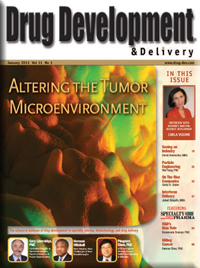issues
January 2011
Download PDFTABLE OF CONTENTS
Pharma’s Innovation Crisis: How Can Our Industry Save Itself?
Derek G. Hennecke, MBA, concludes this 6-part series on business models and best practices for navigating the new normal.
Improved Bioavailability of Engineered Amorphous Nanostructured Compositions of Poorly Water-Soluble Drugs by Rapid-Freezing Particle Engineering Technology
Wei Yang, PhD; Donald E. Owens III, PhD; Jay I. Peters, MD; and Robert O. Williams III, PhD; believe RF technology provides the flexibility to choose various excipients and solvents in drug formulations to tailor the properties of RF-processed drug compositions, accommodating the requirements of various dosage forms for optimal delivery of poorly water-soluble drugs.
On the Rise: Drug Development Companies You Should Know About
In this annual feature, Contributor Cindy H. Dubin examines several lesser-known, but worth knowing, innovators to find out more about their technologies and how they are navigating through the challenging and ever-evolving drug development industry.
A Fit-for-Purpose Strategy Toward Solid Form Screening & Selection
Pingyun Chen, PhD, and David Igo, PhD, highlight the key considerations throughout the solid form selection process and provide a practical framework for developing an appropriate strategy to meet specific technical needs and ensure a successful and cost-effective progression of drug candidates through various development milestones to commercialization.
Controlled Release & Nanotechnologies: Recent Advances & Future Opportunities
Gary Liversidge, PhD, says controlled-release and nanoparticle-based technologies are two of the main market drivers within the drug delivery sector, and outlines the potential opportunities for their separate and indeed combined utilization by the pharmaceutical industry over the coming years.
Advances in Interferon Delivery Methods: A Historical Perspective
Jaleel M. Shujath, MBA, says the clinical application of IFNs to a variety of diseases has been the subject of intense research for the past 50 years. However, in order to harness the enormous potential of IFNs as valid therapeutics, limitations involving their short half-lives and their propensity to induce numerous toxicities must be overcome.
Avantor Performance Materials: New Heights, New Challenges & New Breakthroughs
Drug Delivery Executive: Herman Mitchell, Global Marketing Director, Pharmaceutical Chemicals, talks about his company’s recent developments and how they will impact pharmaceutical customers.
Hovione: What is Special About Inhalation APIs?
Drug Development Executive: Carla Vozone, Director of Business Development for Hovione’s Generics Business Unit, discusses what makes Hovione unique in API supply for inhalation, its supportive technologies, and approach to the market.
The New Role of R&D: Why & How Does it Need to Change?
Rosemarie Truman, PhD, stresses that R&D will need to make mammoth shifts to continue to be at the heart of innovation, ensuring the right drugs, devices, and/or biologics get to market and make their intended impact.
DOS47 – Killing Cancer by Altering the Tumor Microenvironment
Heman Chao, PhD, describes an approach to chemically alter a part of the tumor microenvironment with the goal of developing a cancer therapeutic that can be directly cytotoxic to the tumor cells and/or act synergistically with other chemotherapeutic agents to enhance efficacy and/or tolerability.
COVER
FEATURES


















